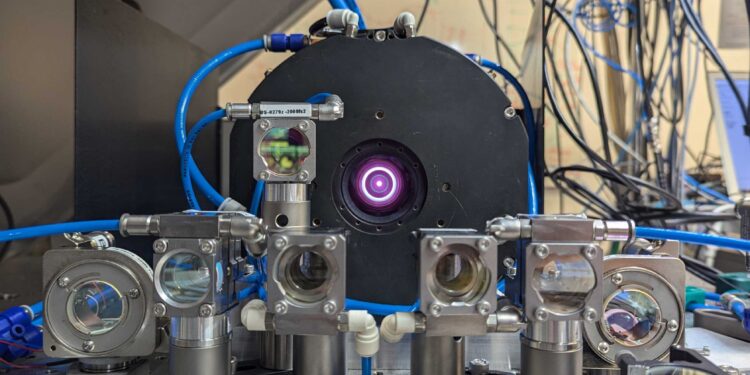A look at the whole system: The laser is visible in the center of the image, with lenses and mirrors in the foreground that reflect and redirect the laser beam. Credit: Moritz Seidel / ETH Zürich
The word laser generally conjures up the image of a highly concentrated and continuous beam of light. Lasers that produce such light are actually very common and useful. However, science and industry often require very short, powerful pulses of laser light.
These pulses can be used to machine materials or to create high harmonic frequencies up to X-rays, which can help make visible extremely fast processes on the order of attoseconds (a billionth of a billionth of a second). .
A team of researchers from ETH Zurich led by Ursula Keller, professor at the Institute for Quantum Electronics, has set a new record for such laser pulses: with an average power of 550 watts, they exceed the previous maximum by more than by 50 percent, making these the strongest pulses ever created by a laser oscillator.
At the same time, they are extremely short – lasting less than a picosecond, or a millionth of a millionth of a second – and exit the laser in a regular sequence at a high rate of five million pulses per second. The short pulses reach peak powers of 100 megawatts (which, in theory, would be enough to power 100,000 vacuum cleaners for a short time).
The researchers recently published their results in the journal Optical.
Over the past 25 years, Keller’s research group has worked on the continuous improvement of so-called short-pulse disk lasers, in which the laser material consists of a thin disk, only 100 micrometers thick , of a crystal containing ytterbium atoms.
Time and again, Keller and his colleagues encountered new problems that initially prevented a further increase in power. Quite often, spectacular incidents occurred in which different parts inside the laser were destroyed. Solving these problems led to new knowledge that made short-pulse lasers, also popular in industrial applications, more reliable.
“The combination of even higher power and a pulse frequency of 5.5 megahertz, which we have now achieved, is based on two innovations,” explains Moritz Seidel, Doctor of Science. student in Keller’s lab. On the one hand, he and his colleagues used a special arrangement of mirrors that send light inside the laser through the disk several times before leaving the laser through a decoupling mirror.
“This arrangement allows us to significantly amplify the light without the laser becoming unstable,” explains Seidel.
The second innovation concerns the centerpiece of the pulsed laser: a special mirror made of semiconductor material, invented by Keller already thirty years ago and bearing the memorable abbreviation SESAM (Semiconductor Saturable Absorber Mirror). Unlike normal mirrors, the reflectivity of a SESAM depends on the strength of the light hitting it.
Legumes thanks to SESAM
Using SESAM, researchers trick their laser into sending short pulses rather than a continuous beam. The pulses have a higher intensity because the light energy is concentrated over a shorter period of time. For a laser to emit laser light, the light intensity inside must exceed a certain threshold value.
This is where SESAM comes in: it reflects the light that has already passed through the amplifier disk several times, particularly effectively if the light intensity is high. The laser then automatically switches to pulsed mode.
“Until now, pulses of comparable power to those we obtained could only be achieved by sending weaker laser pulses through several separate amplifiers outside the laser,” explains Seidel.
The disadvantage is that amplification also causes more noise, corresponding to power fluctuations, which poses problems especially in precision measurements.
To create this high power directly using the laser oscillator, the researchers had to solve a number of tricky technical problems, such as how to attach a thin sapphire window to the semiconductor layer of the SESAM mirror, which Significantly improves mirror properties. .
“When it finally worked and we observed how the laser created pulses, it was really cool,” says Seidel.
Alternative to amplifiers
Ursula Keller is also enthusiastic about these results and says: “We hope to be able to shorten these pulses very efficiently within a few cycles, which is very important for creating attosecond pulses.”
According to Keller, the fast, strong pulses made possible by the new laser could also be used in new frequency combs in the ultraviolet to X-ray regime, which could lead to even more precise clocks.
“A dream would be to one day show that natural constants are ultimately not constant,” says Keller. In addition, terahertz radiation, which has a much longer wavelength than visible or infrared light, can be created with the laser and then used, for example, to test materials.
“Overall, it can be said that with our pulse lasers we have shown that laser oscillators are a good alternative to amplifier-based laser systems and that they enable new and better measurements,” says Keller.
More information:
Moritz Seidel et al, Ultrafast 550 W Medium Power Thin Disk Laser Oscillator, Optical (2024). DOI: 10.1364/OPTICA.529185
Quote: Researchers develop laser that produces the most powerful ultra-short laser pulses to date (October 12, 2024) retrieved October 13, 2024 from
This document is subject to copyright. Except for fair use for private study or research purposes, no part may be reproduced without written permission. The content is provided for informational purposes only.



